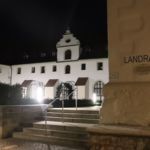- The impressive electoral castle of Amberg
- Directly next to the Amberg city glasses is the electoral castle.
- The front entrance to the Landratsamt leads into a beautiful green area that enhances the former electoral palace.
- The Electoral Palace interpreted as a mandala by the Amberg artist Nina Ferstl.
- The electoral armoury of the night belongs today to the district administration.
A castle to subjugate them
Elector Ludwig III of the Palatinate built a new castle from 1417. It wasn’t like there wasn’t already a residence. However, this was located at the oak forest square in the “Alte Veste”. This was not a problem at all before the new city fortifications were built. However, when the fortification was completed, the Veste was in the middle of the city. However, this no longer seemed safe or even lawful enough for the highborn. As the elector finally built the electoral castle at Amberg.
An unresolved claim to rulership – if you will, because the people of Amberg were behind Philip, a legitimate descendant of Ludwig – led to the so-called “Amberg Rebellion”. Elector Frederick I had seized power and wanted to impose his regency. So he unceremoniously occupied the city with his own troops and had three ringleaders of the uprising executed. Thus he brought the population to its knees, but he was not entirely comfortable with it. He had the Amberg castle rebuilt into a fortress. This virtually meant that he fortified his seat of government facing the city. Thus the castle became a moated castle, which could only be entered via a drawbridge. In the process, the third archway of today’s Amberg city g ates was also filled in and later bricked up.
The outraged population could finally only be appeased by the famous Amberg wedding in 1474.
The Electoral Palace of Amberg in transition
Many fires forced constant alterations and renovations to the castle. Of the then three-winged building, only the south wing, the new castle, is still preserved. In 1621, the notorious Winter King Frederick V was finally defeated in a battle in Prague. The castle became the property of the Jesuit order. The once magnificent residence visibly deteriorated. This culminated in the buildings serving only as material storage. Almost 100 years passed until the electoral castle in Amberg was made habitable again. The last monarch to live in it was Elector Max IV Josef. But even that was only for half a year, because he tried to hide from the Napoleonic troops.
Another part of the castle is the electoral armoury. Since the 19th century, both buildings have served the administration and district councils as pompous offices. Today it houses the district office of the Amberg Sulzbach district.























